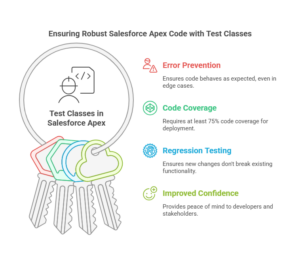Imagine you are building a skyscraper. Before you allow people to move in, you ensure it can withstand earthquakes, high winds, and other stress factors. Similarly, when you develop in Salesforce Apex, you need to test your code to ensure it works seamlessly under all scenarios. This is where the art of writing test classes comes into play. For beginners, understanding test classes is not just about code coverage; it’s about quality and confidence in your applications.
Let’s dive into the story of crafting test classes—one step at a time, simplifying complexities and answering your questions along the way.
Why Are Test Classes Important?
Think of test classes as safety checks for your Salesforce org. Without them, you might deploy code that breaks critical business processes. Here are some key reasons why they are essential:

- Error Prevention: Test classes ensure your code behaves as expected, even in edge cases.
- Code Coverage: Salesforce requires at least 75% code coverage to deploy Apex to production.
- Regression Testing: They help ensure new changes don’t break existing functionality.
- Improved Confidence: Good test classes give developers and stakeholders peace of mind.
Now that we know why test classes matter, let’s learn how to write them effectively.
Getting Started with Test Classes
The Basics
Test classes in Salesforce are written in Apex and are annotated with @isTest. These classes validate the behavior of your Apex code by simulating different scenarios. Here’s a simple example:
@isTest
public class AccountHandlerTest {
@isTest
static void testCreateAccount() {
// Arrange: Set up test data
Account acc = new Account(Name = 'Test Account');
// Act: Perform the action to test
insert acc;
// Assert: Verify the outcome
Account insertedAcc = [SELECT Id, Name FROM Account WHERE Id = :acc.Id];
System.assertEquals('Test Account', insertedAcc.Name);
}
}Key Concepts to Remember
- Isolation: Test classes don’t affect real data in your org. Salesforce provides a separate testing environment.
- Data Creation: Always create test data in your test classes. Don’t rely on existing data.
- Assertions: Use
System.assertmethods to validate outcomes. For example,System.assertEquals(expected, actual)ensures the code produces the expected result.
Writing Effective Test Classes
1. Follow the Arrange-Act-Assert Pattern
This is a golden rule in testing. Break your test methods into three clear sections:
- Arrange: Prepare the data and environment.
- Act: Perform the action you want to test.
- Assert: Verify the result.
Example:
@isTest
static void testCalculateDiscount() {
// Arrange
Opportunity opp = new Opportunity(Name = 'Test Opp', StageName = 'Prospecting', CloseDate = Date.today());
insert opp;
// Act
Decimal discount = DiscountCalculator.calculateDiscount(opp.Id);
// Assert
System.assert(discount > 0, 'Discount should be greater than zero.');
}2. Use Test.startTest and Test.stopTest
Salesforce limits the number of queries and DML operations you can perform in a single transaction. To ensure your test methods don’t hit these limits, use Test.startTest() and Test.stopTest(). This also helps test asynchronous methods like future calls or batch jobs.
@isTest
static void testFutureMethod() {
// Arrange
Account acc = new Account(Name = 'Test Account');
insert acc;
// Act
Test.startTest();
MyFutureClass.myFutureMethod(acc.Id);
Test.stopTest();
// Assert
Account updatedAcc = [SELECT Status__c FROM Account WHERE Id = :acc.Id];
System.assertEquals('Processed', updatedAcc.Status__c);
}3. Test for Positive, Negative, and Edge Cases
Cover all possible scenarios:
- Positive Test: Validate expected behavior for valid inputs.
- Negative Test: Handle invalid inputs gracefully.
- Edge Cases: Test boundaries (e.g., null values, empty lists).
4. Use Mocking for Callouts
Salesforce doesn’t allow HTTP callouts in test methods. Instead, use the HttpCalloutMock interface to simulate responses.
@isTest
static void testCallout() {
Test.setMock(HttpCalloutMock.class, new MockHttpResponseGenerator());
// Act
HttpResponse response = MyCalloutService.makeCallout();
// Assert
System.assertEquals(200, response.getStatusCode());
}5. Check Governor Limits
You can use Limits methods in your test classes to ensure your code efficiently handles large datasets and respects governor limits.
System.assert(Limits.getQueries() < 100, 'Query limit exceeded!');Common Questions Answered
Q1. How many test classes should I write?
Write enough test classes to cover all your code paths. Every method and branch of logic should be tested.
Q2. How can I achieve 100% code coverage?
While 100% coverage isn’t always realistic, aim to cover every possible branch in your code. Use tools like Developer Console to identify uncovered lines.
Q3. Can I use real data in test classes?
No, it’s a best practice to create your own test data to ensure reliability and isolation.
Q4. How do I handle exceptions in test methods?
Use try-catch blocks to validate that exceptions are thrown when expected.
try {
MyClass.myMethod(null);
System.assert(false, 'Expected an exception but none was thrown.');
} catch (Exception e) {
System.assertEquals('Expected Exception Message', e.getMessage());
}Wrapping Up
Writing test classes is not just a task to check off your list; it’s an art that ensures the reliability of your Salesforce applications. Start with small, clear methods, cover various scenarios, and always validate your outcomes. Over time, you’ll find yourself building robust, error-free solutions that stand the test of time—just like a well-built skyscraper.
Happy coding!
Source: Read MoreÂ

